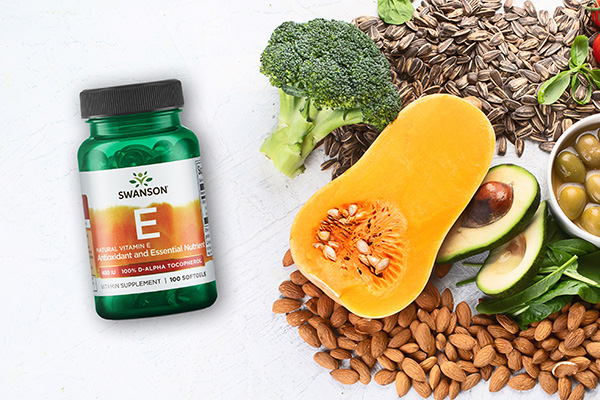Your Guide to the Benefits of Vitamins
Everyone’s heard about letter vitamins and how important they are to our overall health and wellness, but how many of us can explain where vitamins come from, how vitamins benefit our health or even the best way to consume them?
The world of “alphabet vitamins” and their supplement forms is vast and exciting. Think of this as your guide to the benefits of vitamins and all the other bits of information needed to confidently ensure you’re getting the most from your diet and supplements.
Where Do Vitamins Come From?
Vitamins can be thought of as chemical compounds most often found in foods. Our bodies need these nutrients for proper growth, development and function, but many times we can’t make them ourselves, and so must get them from a healthy diet and supplements.1
Some vitamins can be made endogenously. This means that the body can create them internally. An example would be vitamin D. The body creates vitamin D as a reaction to exposure to sunlight.2
However, it isn’t always possible to spend as much time in the sun as we’d like, and even so, our bodies don’t make sufficient amounts of this and other endogenous vitamins, so it’s important to consider diet choices and supplementing to make sure we’re getting enough vitamin D and other vitamins.
When it comes to getting the vitamins we need, it’s important to understand the different types of letter vitamins available, along with understanding their relative benefits to our health.
Types of Vitamins
Vitamins can be thought of as either fat-soluble or water-soluble. This distinction is based on how they are absorbed and metabolized by the body, and whether or not they can be stored by the body for later use.
Fat-soluble vitamins include D, K, E and A. These vitamins are best absorbed into the bloodstream in the presence of fat from food and can be stored in the body’s fat cells for later use if needed.3 If you’re supplementing one of these vitamins, you’ll want to take your supplement with a meal that includes at least some healthy fats.
Water-soluble vitamins include vitamin C and the family of eight B vitamins. These vitamins dissolve and are best absorbed into the bloodstream with water.3 They cannot be stored within the body but are instead flushed out as part of the regular urinary function. For this reason, it is important to maintain proper hydration and to make sure you take any vitamin C or B supplements with a glass of water (as opposed to milk, for example) for best absorption and metabolism.
Benefits of Vitamins
Now that we have a better understanding of the types of vitamins, let’s look at their specific health benefits and the best real food sources for enjoying those benefits.
Vitamin A
The chemical structure of vitamin A was first described in 1932, although the vitamin was properly identified as early as 1920.4
Vitamin A is known to offer critical support for growth and development in children, particularly in the areas of vision health and bone density. Vitamin A is associated with digestive health,3 immune system function, reproductive health and as a source of antioxidant support for healthy organs.
Beta-carotene, found in colorful fruits and vegetables, is an example of a carotenoid which the body converts into vitamin A to support vision health.5
Retinol is a form of vitamin A which is used for skin vitality by promoting cellular health of the skin and supporting collagen formation.6
Vitamin A can be found in many food sources. Foods that provide vitamin A include eggs and milk, in addition to fruits like carrots or mangoes.7
Vitamin B
First described as “water-soluble factor B” by a professor at the University of Wisconsin in 1913,8 vitamin B actually represents eight distinct water-soluble vitamins which deliver powerful, often overlapping, benefits to overall health and wellness.
The family of B vitamins offer a range of health benefits, with some supporting enzymatic function or promoting digestion, while others bolster brain health and other functions.9 Some of the vitamins in this family have also been linked to healthy hair, skin and nails along with boosting energy production, while others even support cognitive function and neurological health.10
Whole food sources of vitamin B can include vegetables, nuts, dairy products, eggs, meat and fish. Unlike most others in this family, vitamin B12 is primarily found in meat or dairy products, and not in fruits or vegetables, so vegans or vegetarians may want to consider supplementing this vitamin to ensure optimal health.11
Vitamin C
This amazingly potent water-soluble vitamin and antioxidant was first isolated in 1928, an important discovery as the human body can’t form vitamin C endogenously,12 and therefore must get ample amounts from diet or supplementation. For this reason, incorporating foods rich in vitamin C, along with finding the best vitamin C supplements, is a critical part of maintaining overall wellbeing.
Vitamin C is known to support tissue health and collagen synthesis. It also promotes absorption of essential minerals like iron, supports bone health and is perhaps most associated with its powerful support of immune health.3 Vitamin C also delivers potent antioxidant protection against free radicals, the molecules produced by the body in response to exposure to pollution or as part of the normal metabolic process.13
Vegetables like potatoes and fruits such as tomatoes, oranges or lemons are some of the best food sources of vitamin C.7
Vitamin D
This vitamin’s chemical structure was first discovered by scientists a century ago, with the body’s metabolism of vitamin D finally being described in 1967. In the years since, medical science has continued to discover various ways in which this essential nutrient works to benefit not only bone health, but the overall vitality of many tissues and functions within the body.14
The “Sunshine Vitamin” is particularly important for bone health, muscle health, maintaining proper blood flow and immune support. Considered both a vitamin and a hormone, vitamin D supports the body’s absorption of minerals like calcium and phosphorus. It has also been studied for its support of cellular function related to healthy blood glucose response and may have positive effects on arterial flexibility and other aspects of generalized cardiovascular wellness.15
Although the human body can synthesize vitamin D endogenously, this typically requires a healthy amount of sunlight exposure, which isn’t always possible. Additionally, few foods offer sufficient amounts of vitamin D to ensure you’re getting enough from diet alone.15 In fact, it's believed that more than 88% of people worldwide have sub-optimal levels of vitamin D in their systems. That’s why some governments, such as Switzerland and Finland recommend supplementing vitamin D.21 Some foods which may offer vitamin D include fortified cereals and dairy products in addition to fatty fish and some fish liver oils.7
Vitamin E
Vitamin E was initially discovered in 1922, with scientists continuing to uncover more about this powerful antioxidant in the decades after.16 In fact, this vitamin served as the original inspiration for Leland Swanson to launch Swanson Health in 1969 after his search for a supplement that would promote joint health.
As an antioxidant, vitamin E benefits overall wellness by providing protection against free radicals. The health benefits of vitamin E also include promoting healthy skin and eyes and even supporting reproductive health.17
Vitamin E is available in supplement form, but you can also find it in many foods such as green vegetables like broccoli and spinach, or in peanuts or almonds. Vitamin E is also present in vegetable oils.7
Vitamin K
The family of K vitamins was first identified almost by accident in 1929 and was quickly associated with healthy blood function. Scientists are still researching vitamin K and its benefits, with identification of new vitamin K dependent proteins (VKDP) continuing until as recently as 2008.18
Vitamin K delivers benefits to heart health by activating the osteocalcin and matrix GLA proteins that regulate the distribution of calcium throughout the body, thereby helping to prevent its concentration along the linings of blood vessels. This effect on calcium also aids the blood in performing other healthy functions, and in a similar way, vitamin K promotes absorption of calcium by bones and joints, thereby supporting overall osteo health.19
Vitamin K can be found in foods like cheese and eggs, but also in leafy vegetables like kale or spinach. It can also be found in fruits like figs or even blueberries.7
How to Take Vitamins
The best time to take vitamins will vary depending on the type of vitamin. For example, if you’re taking a fat-soluble vitamin, you’ll want to take it with a meal. Water-soluble vitamins like vitamin C or vitamin B12 should be taken with a glass of water, preferably in the morning since they and other B vitamins can increase energy production and metabolism.20
Of course, some vitamin supplements are available in creams or liquid forms, so for these it’s always best to follow the label instructions.
Vitamins for the Win!
Vitamins are an essential and foundational part of our overall health and wellness. By learning which ones our bodies may need most and adjusting our diets or supplement regimens accordingly, we can do our part to help support long-term wellness easily and with confidence.
You be well, now
Swanson
*These statements have not been evaluated by the Food and Drug Administration. These products are not intended to diagnose, treat, cure, or prevent any disease.
Sources
- What are Vitamins? Medical News Today. Read source
- Overview of Vitamin D. National Library of Medicine. Read source
- Fat-Soluble vs Water-Soluble Vitamins. Very Well Health. Read source
- Vitamin A. National Library of Medicine. Read source
- Vitamin A and Carotenoids. National Institutes of Health. Read source
- Retinol. Cleveland Clinic. Read source
- Vitamins and Minerals. National Institute on Aging. Read source
- The Vitamin B Complex. American Chemical Society. Read source
- Health Benefits of B Complex. WebMD. Read source
- B Complex Vitamins. HealthLine. Read source
- B Vitamins and Folic Acid. National Health Service (UK). Read source
- The Discovery of Vitamin C. National Library of Medicine. Read source
- Vitamin C. Mayo Clinic. Read source
- 100 Years of Vitamin D. Endocrine Connections. Read source
- Vitamin D. Harvard School of Public Health. Read source
- History of Vitamin E. PubMed. Read source
- Vitamin E. Mayo Clinic. Read source
- The Discovery of Vitamin K. PubMed. Read source
- Proper Calcium Use. Integrative Medicine: A Clinician’s Journal. Read source
- The Best Time to Take Vitamins. Cleveland Clinic. Read source
- Bridging the Vitamin D Gap. IADSA. Read source



